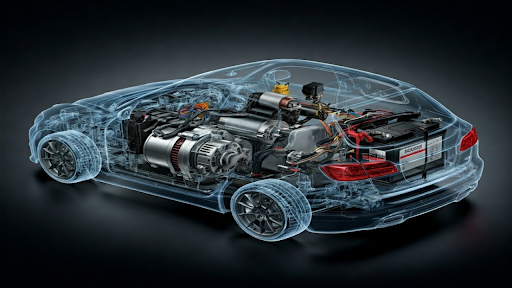How Automotive Electrical Systems Power Your Vehicle: A Comprehensive Guide
Automotive electrical systems are the unseen lifeblood of modern vehicles. From starting the engine to powering headlights, infotainment, and advanced driver-assistance systems, automotive electrical systems play a vital role in vehicle operation and safety. Whether you’re a car enthusiast, a mechanic, or simply a curious driver, understanding how automotive electrical systems work can deepen your appreciation of the complex engineering inside every vehicle.
This article will explore the fundamentals of automotive electrical systems, explain the key components, describe how electricity flows through a car, and discuss common issues and maintenance tips. We will also answer frequently asked questions about automotive electrical systems to ensure you get a thorough understanding of this essential topic.
What is an Automotive Electrical System?
The automotive electrical system refers to the network of electrical components and wiring within a vehicle that manages power distribution and communication between various devices. Unlike older vehicles that relied heavily on mechanical parts, modern cars depend extensively on electrical systems to operate everything from ignition and fuel injection to lighting, sensors, and onboard computers.
In simple terms, the automotive electrical system is the vehicle’s nervous system, controlling and supplying power to every electrical part, ensuring the car functions smoothly and safely.
Key Components of Automotive Electrical Systems
To understand automotive electrical systems, it’s essential to know the primary components involved:
1. Battery
The battery is the heart of the automotive electrical system. It stores electrical energy as chemical energy and supplies power needed to start the engine and run electrical devices when the engine is off. Most modern vehicles use a 12-volt lead-acid battery.
2. Alternator
Once the engine is running, the alternator takes over as the main power source. It converts mechanical energy from the engine’s crankshaft into electrical energy, recharging the battery and supplying electricity to the car’s systems.
3. Starter Motor
The starter motor uses electrical power from the battery to turn over the engine during startup. This motor initiates the combustion process, allowing the engine to run on its own.
4. Wiring Harness
The wiring harness is a complex bundle of wires that distribute electrical power and signals throughout the vehicle. It connects all components of the automotive electrical system, ensuring communication and power flow.
5. Fuses and Relays
Fuses and relays protect electrical circuits from damage by preventing overcurrent and allowing safe switching of high-power devices.
6. Sensors and Control Modules
Modern automotive electrical systems include numerous sensors (e.g., oxygen sensors, temperature sensors) and control modules (computers) that monitor and regulate vehicle functions for efficiency and safety.
How Automotive Electrical Systems Work: The Flow of Electricity
At its core, the automotive electrical system operates by moving electrical current from the battery to different components and then returning to the battery. The car’s metal chassis acts as a ground, completing the electrical circuit.
When you turn the ignition key or push the start button:
- The battery sends voltage to the starter motor.
- The starter motor cranks the engine.
- The alternator starts producing electricity as the engine runs.
- The alternator supplies power to the car’s electrical devices and recharges the battery.
- Electrical current flows through the wiring harness to components such as lights, dashboard instruments, and infotainment systems.
The electrical system works with both direct current (DC) and alternating current (AC) internally, but most automotive components use DC power at 12 volts.
Voltage, Amperage, and Watts in Automotive Electrical Systems
Understanding the basic electrical terms is crucial for grasping how automotive electrical systems operate:
- Voltage (Volts) is the electrical pressure pushing electrons through a conductor.
- Current (Amperes or Amps) is the flow rate of electric charge.
- Power (Watts) is the rate of energy transfer, calculated as Voltage × Current.
In automotive electrical systems, the voltage typically remains at about 12 volts, but amperage can vary depending on the device’s power requirements.
Common Automotive Electrical Devices and Their Roles
Here are some common automotive electrical devices and their functions:
- Headlights and Taillights: Provide illumination and signaling.
- Ignition System: Powers spark plugs to ignite the air-fuel mixture.
- Fuel Pump: Delivers fuel from the tank to the engine.
- Dashboard Instruments: Display vital information to the driver.
- Power Windows and Locks: Operate doors and windows electronically.
- Infotainment Systems: Provide navigation, music, and connectivity.
- Climate Control Systems: Regulate heating and cooling.
- Advanced Driver-Assistance Systems (ADAS): Includes sensors and cameras for safety.
Troubleshooting Automotive Electrical Systems
Common issues in automotive electrical systems include dead batteries, faulty alternators, blown fuses, and wiring problems. Symptoms can range from a car that won’t start to flickering lights or malfunctioning electronics.
Basic Troubleshooting Tips:
- Check the Battery: Test voltage and condition; replace if weak.
- Inspect Fuses and Relays: Replace any blown fuses.
- Look for Loose or Corroded Connections: Clean and tighten terminals.
- Test the Alternator Output: Use a multimeter to ensure proper charging voltage.
- Scan for Error Codes: Modern cars’ onboard diagnostics (OBD) can help identify electrical faults.
Maintenance of Automotive Electrical Systems
Proper maintenance ensures reliability and longevity of automotive electrical systems:
- Regularly inspect battery terminals for corrosion.
- Keep wiring harnesses clean and secure.
- Replace worn-out fuses and relays promptly.
- Use quality replacement parts.
- Have your electrical system checked during routine vehicle servicing.
The Future of Automotive Electrical Systems
With the rise of electric vehicles (EVs) and hybrid technology, automotive electrical systems are becoming even more complex and critical. High-voltage batteries, electric motors, sophisticated electronics, and extensive sensor networks define the future of automotive electrical engineering.
Understanding the fundamentals of automotive electrical systems today provides a foundation for navigating tomorrow’s automotive technologies.
Frequently Asked Questions (FAQs)
1. What voltage do automotive electrical systems use?
Most automotive electrical systems use a 12-volt DC system in gasoline and diesel vehicles. Electric vehicles may use higher voltage systems, often 400 volts or more.
2. How long does a car battery last?
Typically, car batteries last 3 to 5 years, depending on usage, climate, and maintenance.
3. Can I jump-start a car with a dead battery?
Yes, you can jump-start a car by connecting it to another vehicle’s battery using jumper cables.
4. What causes a car’s electrical system to fail?
Failures can be caused by a dead battery, faulty alternator, corroded connections, blown fuses, or damaged wiring.
5. How do I know if my alternator is bad?
Signs include dimming headlights, battery warning light on the dashboard, and difficulty starting the car.
6. What is a wiring harness?
A wiring harness is a bundled collection of wires and connectors that transmit electrical power and signals throughout the vehicle.
7. Are automotive electrical systems dangerous?
They can be if improperly handled, especially high-voltage systems in electric and hybrid vehicles. Always follow safety guidelines or consult a professional.
8. How often should I check my automotive electrical system?
It’s recommended to have the electrical system inspected during routine vehicle maintenance or if you experience electrical issues.
9. Can electrical problems affect fuel efficiency?
Yes, faulty sensors or electrical components can cause inefficient engine performance and reduced fuel economy.
10. What tools do I need to work on automotive electrical systems?
Basic tools include a multimeter, wire strippers, electrical tape, fuses, and a wiring diagram for your vehicle.
Conclusion
Automotive electrical systems are the backbone of modern vehicles, enabling a wide array of functions that make driving safer, easier, and more comfortable. From the battery to the alternator and the intricate wiring harness, each component plays a critical role in ensuring your vehicle operates correctly.
By understanding the principles of automotive electrical systems, recognizing common problems, and practicing proper maintenance, you can help ensure your vehicle’s electrical system remains reliable for years to come.
If you want to dive deeper or need help troubleshooting your vehicle’s electrical system, consulting a professional automotive electrician or mechanic is always a wise choice.
Explore exclusive insights and updates on the latest trends at nhlwebcast.org.





